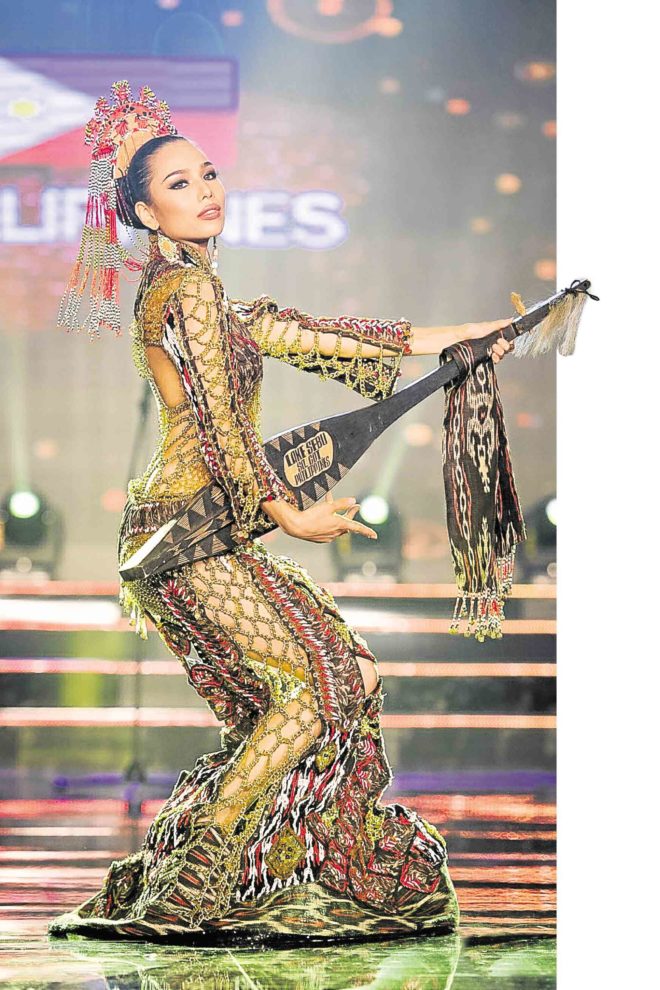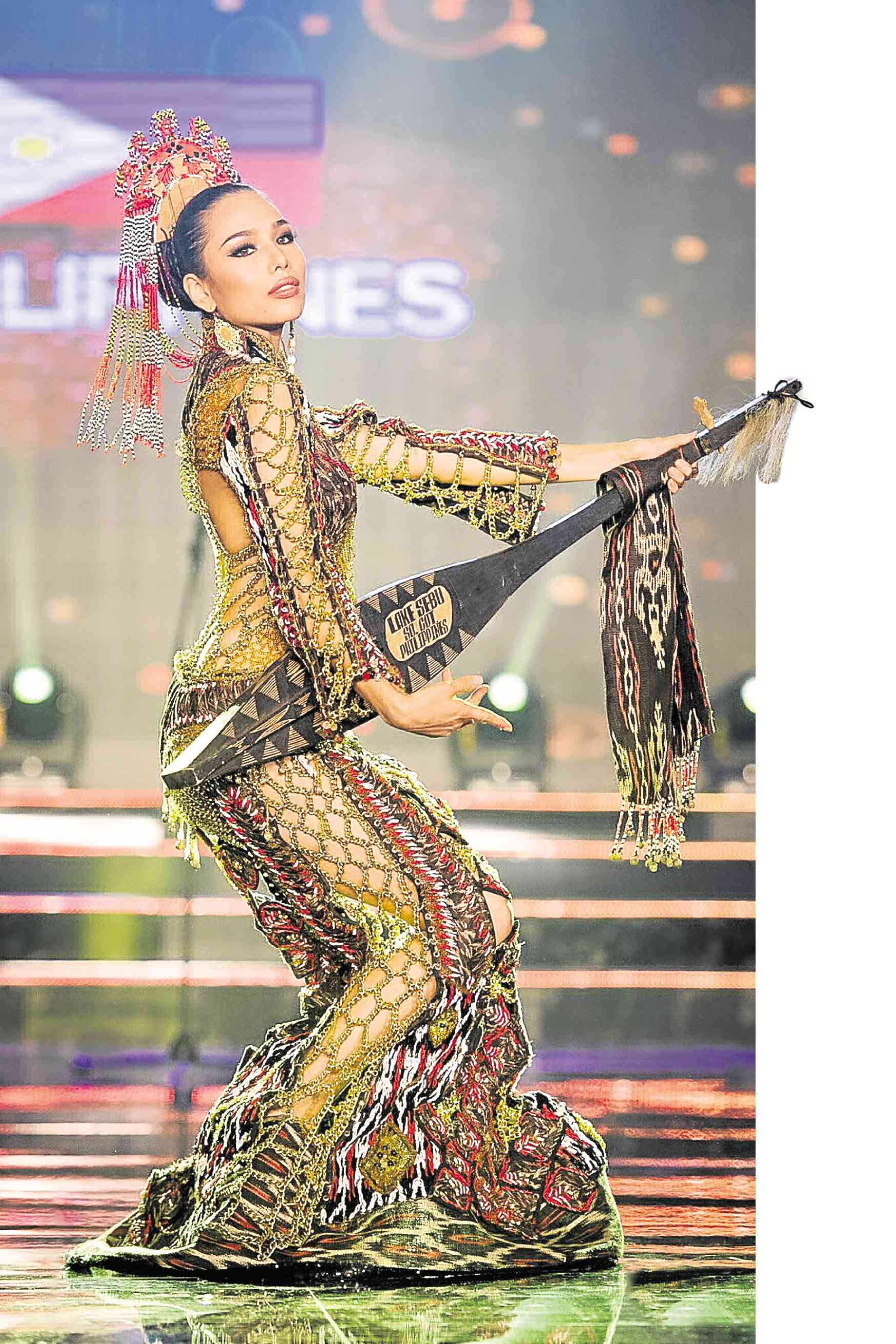
The various creative and ethical considerations that define fashion, as with any craft, encourage designers—especially those who use indigenous materials—to reflect on where to draw the line between upholding tradition, employing cultural appropriation and welcoming innovation.
A recent case worth examining is the national costume of Elizabeth Clenci for Miss Grand International. Her avant-garde t’nalak-inspired dress was designed by Jear Sond Demavivas.
Demavivas is a seasoned designer from Koronadal, South Cotabato. His Instagram photos show his skillful and strong command of fashion design, manipulating fabrics—including t’nalak—and indigenous materials to produce ensembles for men and women.
His experience in creating designs for local and international pageants, weddings, and private functions has earned the trust of clients here and abroad.
Demavivas has dressed beauty queens, celebrities and politicians, among them: Miss Universe Philippines 2017 Rachel Louise Peters, Miss Universe Philippines 2014 Mary Jean Lastimosa, Camarines Sur Gov. Miguel Luis Villafuerte, performing artist Lani Misalucha, actresses Heart Evangelista and Jodi Sta. Maria, and model Monika Sta. Maria.
He looks up to Olivier Rousteing and identifies “Project Runway Philippines 4” finalist and fashion designer Jared Servano as one of his mentors.
Demavivas also won first runner-up in the Mega Young Designers Competition in 2011.
“This dress was inspired by the massive creativity of the T’boli tribe,” Demavivas said in an Instagram post. “This is a representation of a modern T’boli princess in haute couture and the uniquely designed guitar called hegelung.”
No doubt, Clenci floored the competition with her beauty and her national costume. But what other messages did she convey as she posed for the camera, with the sides of her body revealed by her scanty outfit?
Cultural workers and fashion designers weigh in on the matter.
Thorough consultation
Carlo Ebeo, cultural worker and former vice chair of the National Commission for Culture and the Arts’ (NCCA) National Committee on Cultural Education, said that there should have been a thorough consultation with the communities and cultural workers represented by Clenci’s national costume.
While it is admirable to see the post-modern creativity of fashion designers today, and “as much as their works are really beautiful, these might not be accepted by some communities, especially when the sides of the body are revealed,” Ebeo said.
“Whom do you glorify [when you’re on stage]? Yourself? Or the community that you represent?” he asked, adding that legal consultations, although optional, could have developed the dress more.
Ethical considerations should also be part of the creative process, he pointed out.
Michael Angelo Yambok, head of the T’boli cluster of the NCCA’s Subcommission on Cultural Communities and Traditional Arts, echoed this message. Yambok is a T’boli from Lake Sebu.
“The national costume design for Miss Grand International was very amazing,” Yambok said. “Demavivas’ design is just an inspiration from our tribe, using the t’nalak fabric, the Hegelung (T’boli guitar) and the Sewat (headdress). In totality, it is just an inspiration. He recognized the tribe in his design and that is important. But next time around, seek approval from the community. We have cultural experts, and the right office who could be of help to him.”
Yambok explained that his office advocates cultural sensitivity supported by laws that oversee matters like these: RA 8371 or the Indigenous Peoples (IPs) Rights Act of 1997 and the Free, Prior and Informed Consent of the National Commission on Indigenous Peoples.
“We do appreciate people who promote our crafts on the international stage, but we do also want that our cultural identifiers are respected,” he said.
Yambok noted that the t’nalak is widely used in South Cotabato. The fabric is available in the market. Annual festivities like the t’nalak Festival every July celebrate local artistry with “haute couture” fashion design contests.
Some elders express displeasure at some of the fashion, he said, but ultimately, it’s recognition of the tribe—the source of the fabric—that matters.
Courteous practices
Emi Englis, Davao Fashion and Design Council member and award-winning fashion designer and educator, said that designers should connect with communities.
“It would be best that designers who wish to integrate cultural elements in their work, especially that of the indigenous peoples, do research intently and immerse themselves in the communities,” he said. “That way, you have first-hand information on the culture and how it is lived. Your perspective is then changed and your awareness is more grounded. The context is important when you experience it with the actual pride of place.”
He added: “In appropriation, propriety is a must. Understand the essence and extent of the use of forms and functions. For example, nobody would want to wear a garment to a red-carpet event with a textile allocated for the dead.”
In Davao City, councilor Halila Sudagar, committee chair of cultural communities and Muslim affairs, is drafting an ordinance that aims to protect the welfare of both the Indigenous Cultural Communities and the fashion designers. The ordinance is to be endorsed for second reading this November. If it is approved, cultural consultations and orientations will be mandatory when doing IP representations through clothing.
“I want IP culture and traditions to be protected. At the same time, I want fashion designers to have the freedom to present their ideas through their creations,” Sudagar said.
Young Davao designer Wilson Limon, who has worked with weavers in Lake Sebu, South Cotabato, said that he learned from the weavers that cutting the t’nalak was prohibited in the old days.
“The fabric is considered sacred, thus it has a great value,” he said, adding that Jenita Eko, president of the Lake Sebu Indigenous Women Weavers Association Inc., told him that before cutting the fabric, the tribe performed rituals, like biting the fabric and placing it on the forehead as a form of respect.
Edgy and daring
Jennie Arado, a Davao newspaper reporter from Koronadal, South Cotabato, said it is common to see edgy and sexy fashion pieces made with indigenous fabric in local pageants in her hometown.
“It’s common, but no one points it out because everyone is used to seeing these,” she said.
JGG, a South Cotabao local who requested anonymity, has been witness to these events for many years. There is the Mutya ng South Cotabato every July, and Lakambini ng Koronadal every January 16.
Comparing Clenci’s national costume with the ones he’s seen in his hometown, JGG said he had seen more daring t’nalak-inspired outfits in the Mutya ng South Cotabato tilt.
Cyril Fernandez, another local, pointed out that if innovating on the t’nalak fabric is an issue to the tribe, they wouldn’t be selling it themselves. Tribal weavers even participate in t’nalak “haute couture” competitions, he said.
“This idea of the t’nalak cloth as a sacred material to the T’boli is not new to us in South Cotabato, and it’s not that we’re neglecting it,” he added. “Try to go to T’boli communities in Lake Sebu and you’ll see the t’nalak transformed into souvenir materials such as wallets or coin purses. Some are even used as canvases for paintings. And these are produced by locals.”
Jesus Allaga Montajes, cultural worker and Ateneo de Davao University program officer for culture and arts, said: “Fashion as a medium of creativity lacks cultural sensitivity.”
He challenges Filipino designers to work on this shortfall: “Retain the integrity of one’s cultural community. Respect tradition. Recreate their material culture by correct appropriation. Never settle for cultural bastardization, such as Clenci’s national costume.” –CONTRIBUTED
The author sparked a discussion in social media after commenting on a photo of Clenci’s national costume. He reached out to Demavivas for an interview, but the designer politely declined through a Facebook post.









































